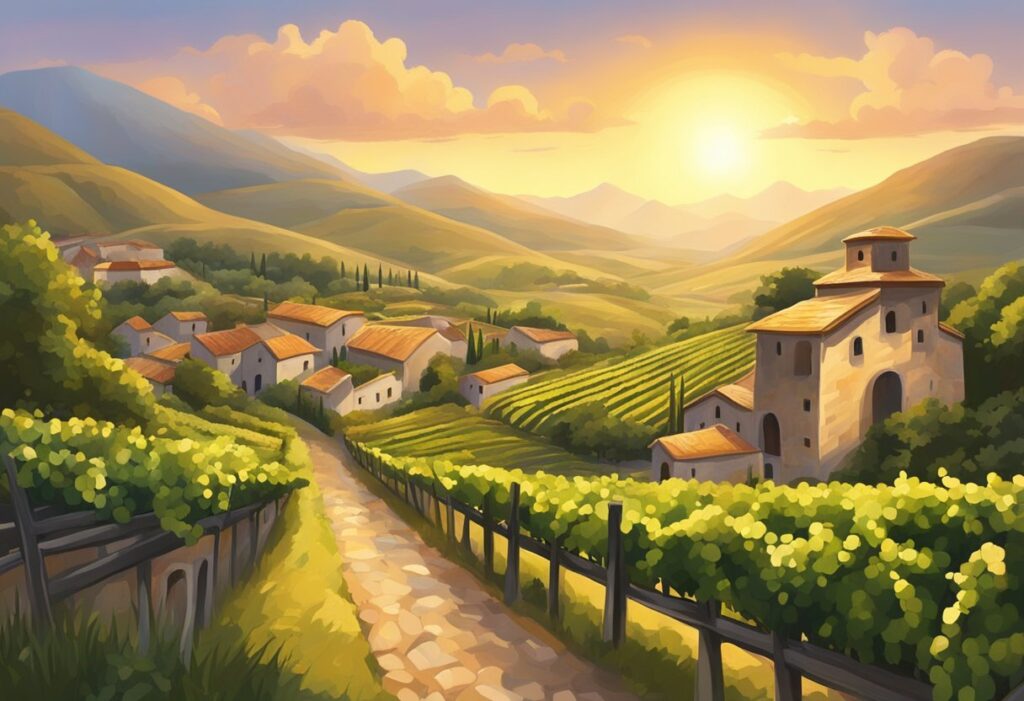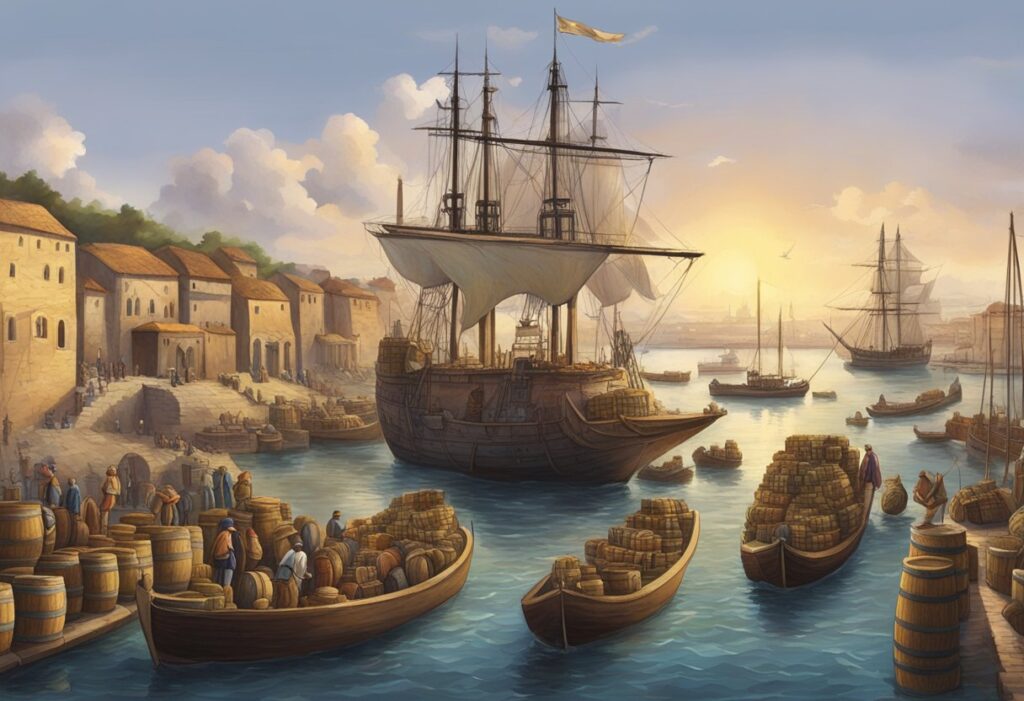Exploring the world’s notable wine regions reveals a story that intertwines geography, history, and culture. It’s in these areas that winemaking has not only perfected its craft but also become a testament to regional identity.
As you journey into the histories of viticulture, you uncover the ancient roots of winemaking in regions like Georgia, where evidence suggests wine was produced as far back as 6000 BC. Traditions have evolved since those early days, yet the reverence for wine’s cultural significance remains unwavering.
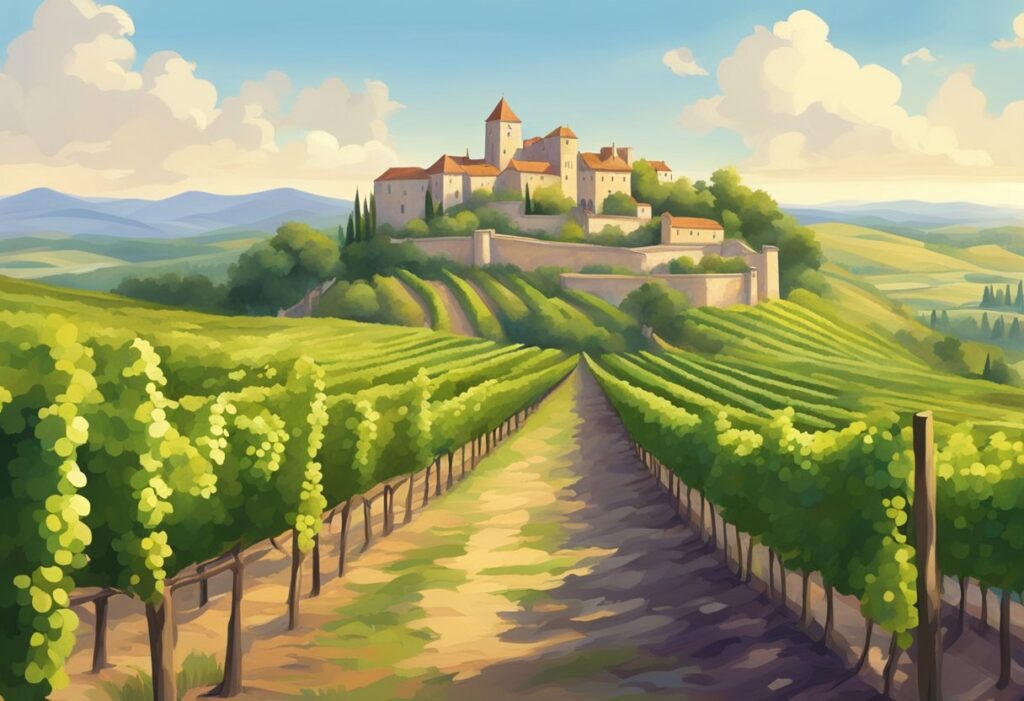
In Europe, centuries-old winemaking techniques have shaped the wines we know today—wines that tell the tale of their homeland’s climate and terrain. The Old World regions, such as Bordeaux and Tuscany, are steeped in a legacy where wine is as essential to their culture as their language.
Meanwhile, New World regions like Napa Valley and Barossa Valley have emerged, bringing with them innovative techniques and a spirit of experimentation. The wine industry has flourished, with vineyards adapting to various climates and boasting a vast array of grape varieties, each leading to unique flavors and styles that contribute to the global wine tapestry.
Climate plays a key role in shaping the characteristics of wine, where the subtleties of temperature, sunlight, and soil composition are reflected in every bottle. As you explore these regions, you’ll discover how winemakers harness these elements, employing both time-honored and modern methods to perfect their craft. These wines are more than a beverage; they are a narrative of the region’s history, the resilience of its people, and the innovations that pave the way for its future.
Key Takeaways
- The origin of winemaking dates back millennia, highlighting the deep historical and cultural ties of wine to many regions.
- European traditions have deeply influenced winemaking, while New World regions continue to innovate and expand the industry.
- Climate and terroir are crucial in shaping the unique profiles of wines, reflecting the diversity of the wine industry and winemaking practices globally.
The Birthplace of Wine
Tracing the origins of wine leads you to ancient civilizations where viticulture formed the cornerstone of culture and economy. Discovering the earliest wine production offers insight into how this cherished beverage influenced human history.
Ancient Georgian Viticulture
Georgia holds a significant claim to being the oldest wine region, with evidence of wine production dating back over 8,000 years. This is supported by the archaeological discoveries of ancient wine residue in clay jars, known as qvevri, which have been used in Georgian wine-making for millennia. These artifacts illuminate the ancient traditions of Georgian viticulture, linking back to the Neolithic period.
Middle Eastern Beginnings
Advancing the narrative of wine, the Middle East plays a pivotal role. Regions like Iran have contributed to the history of wine with findings illustrating the presence of wine from as early as 5,000 BC. Here, the domestication of the wine grape and development of viticulture signaled the spread of wine culture.
Egyptian and Greek Contributions
In Egypt, wine became a symbol of status and divinity. Winemaking practices were often recorded on tomb walls, and you can find traces of Egyptian wine in jars, emphasizing its significance in rituals and daily life. Meanwhile, ancient Greece further developed the wine trade and culture, as evidenced by the widespread use of amphorae to store and transport wine. Their influence was paramount as wine culture spread throughout the Mediterranean.
Europe’s Wine Heritage
Europe’s wine regions stand as historic benchmarks for quality and diversity. With a legacy that intersects with cultural, religious, and political realms, these vineyards and the wines they produce are embedded in the very fabric of European identity.
French Vinicultural Dominance
France’s reputation in winemaking is unparalleled, with regions like Bordeaux, Champagne, and Burgundy setting the global standard. Your appreciation for French wine intensifies when you consider Bordeaux’s role in developing fine red blends and Champagne’s creation of the celebratory sparkling wine we relish. Burgundy, however, champions single-varietal wines, showcasing the heights Pinot Noir and Chardonnay can achieve in its hallowed ground.
Italian Wine Tradition
Your exploration of Italy’s wine heritage involves more than just enjoying a glass; it’s about understanding a tradition deeply rooted in history. The rolling hills of Chianti are synonymous with the robust Sangiovese grape, an Italian staple. Through Italy’s expansive vineyards, you’ll find a medley of grape varieties, each with a unique story, stretching from the sun-kissed Mediterranean coast to the Alpine north.
Spanish Wine Landscape
Moving to Spain, the Rioja region stands out with its luscious Tempranillo-based wines, embodying a landscape rich with wine lore. Spanish winemaking isn’t just about the bold flavors; it’s about a culture that weaves wine into daily life and festive occasions. The upkeep of tradition and the adoption of innovative practices can be witnessed across the Iberian Peninsula, anchoring Spain’s place in the winemaking world.
German Riesling and Beyond
Germany may be famed for its crisp and aromatic Riesling, but there is far more behind the labels of these distinctive bottles. Stemming from steep, riverside vineyards, German wines offer a variety of flavors that go beyond Riesling’s apple notes—many showing surprising complexity and aging potential. Germany embodies a cooler-climate winemaking prowess, a testament to the adaptability and resilience of viticulture.
As you traverse through Europe’s wine regions, your senses are not merely treated to an array of flavors but are also engaged in an ongoing historical narrative.
Every bottle uncovers layers of the past, from monastic vineyards that once played a pivotal role in preserving winemaking knowledge to laws like those stemming from medieval traditions that governed wine production and quality. Embrace this journey through Europe’s wine heritage, where each sip brings you closer to understanding the heart and soul of these timeless landscapes.
New World Wine Expansion
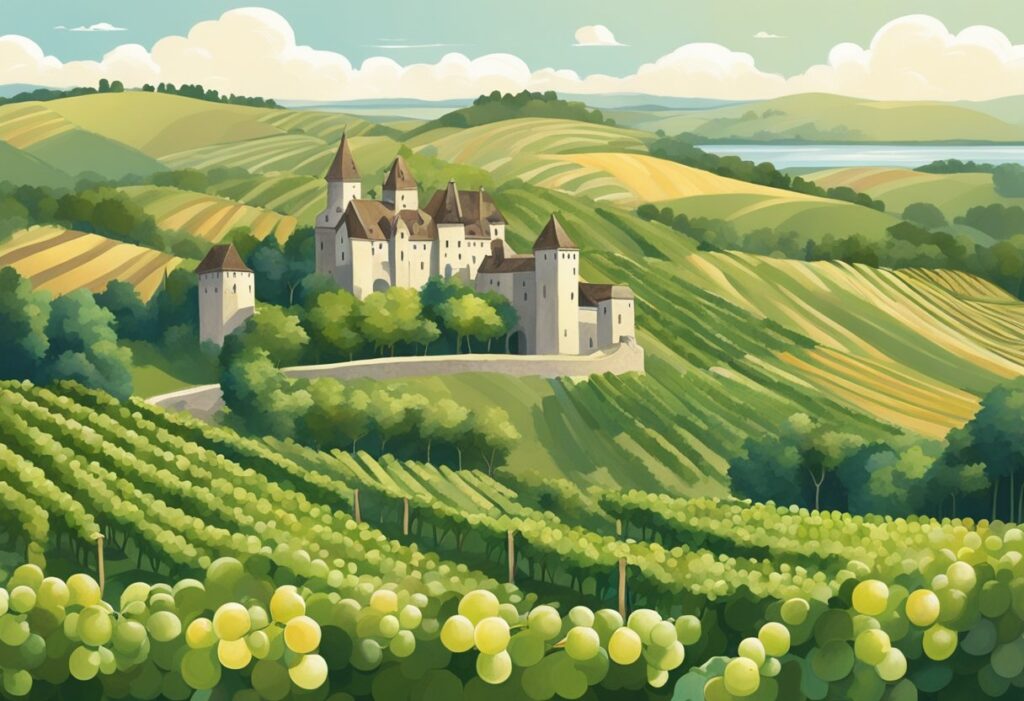
The term “New World” in wines refers to regions outside the traditional wine-growing areas of Europe, where viticulture has flourished in modern times.
The Rise of American Viticulture
Your exploration of New World wines would be incomplete without appreciating the United States, particularly California. California has earned its reputation through regions like Napa Valley and Sonoma, where the production of wine has a rich tradition that spans over a century. Despite the setback of Prohibition, the American wine industry surged, with states like Oregon and Washington also making their mark with varieties like Pinot Noir and Cabernet Sauvignon.
Southern Hemisphere Horizons
Look to the Southern Hemisphere for diverse climatic conditions that have given rise to exceptional wine regions. Australia is renowned for its Shiraz, while South Africa continues to earn praise for its Chenin Blanc and Pinotage. Across the ocean in South America, Argentina stands out with its high-altitude vineyards, perfect for Malbec, as well as Chile with its signature Carmenere. New Zealand, while known for its Sauvignon Blanc, is also gaining recognition for its Pinot Noir.
Emerging Wine Countries
As you broaden your wine palette, you’ll discover emerging wine countries. China, with its rapidly growing vineyards, is becoming a noteworthy player. South of the United States, Mexico’s wine culture is deepening, particularly in regions like Baja California. Even Brazil is emerging on the world stage, with its sparkling wines gaining international attention.
Canadian and New York Vines
Travel north to Canada, where the cool climate regions of Ontario and British Columbia are excellent for Rieslings and Icewines. Not to be overlooked, New York’s Finger Lakes region is producing world-class wines, revealing the diverse capabilities of the New World’s cooler viticultural areas.
Wine Grape Varieties and Their Homelands
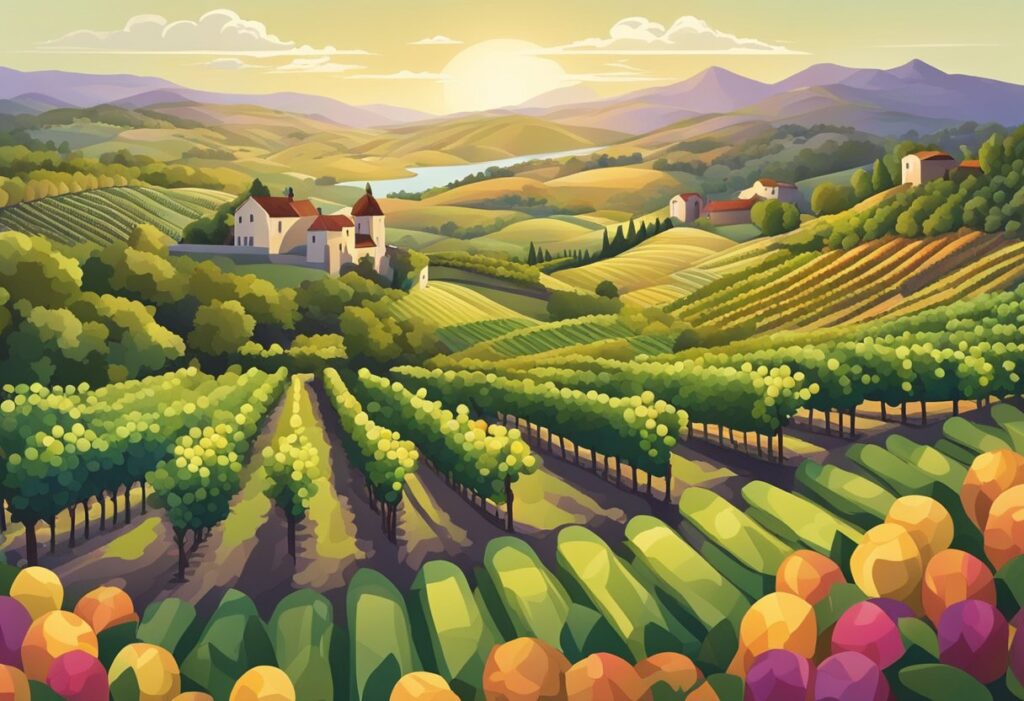
When you consider the vast array of wine grape varieties, their homelands often play a crucial role in defining the distinct flavors and characteristics you’ve come to love. Renowned regions have shaped the identity of these grapes, leading to a fascinating interplay between variety and place.
Red Grape Varietals
Cabernet Sauvignon found its first home in France’s Bordeaux region, where it still reigns supreme. This grape thrives in diverse climates, which is why you’ll also enjoy its robust presence in wines from Napa Valley.
Merlot, also native to Bordeaux, offers a more subtle and soft profile when compared to its regional sibling, Cabernet Sauvignon.
The Pinot Noir grape, with its roots in Burgundy, France, is known for its delicate and complex flavors that vary remarkably based on where it’s grown.
The versatile Syrah, originating from the Rhone Valley, has spread worldwide, dominating regions such as Australia, where it’s known as Shiraz, contributing peppery and savory notes to the wines.
White Grape Origins
The Chardonnay grape is synonymous with the Burgundy region of France. It adapts well to various climates, producing a wide spectrum of flavors from rich and buttery in California to steely and crisp in Chablis.
Sauvignon Blanc calls the Loire Valley and Bordeaux its ancestral homes. This grape is responsible for zesty and refreshing wines, prominent in New Zealand’s Marlborough region.
Riesling, with its origins in Germany’s Rhine region, is beloved for its ability to express terroir and ranges from sweet to bone-dry.
Lastly, the versatile Chenin Blanc, hailing from the Loire Valley, is a chameleon of sorts, utilized in everything from sparkling wines to well-balanced dessert wines.
Climate Influence on Wine Production
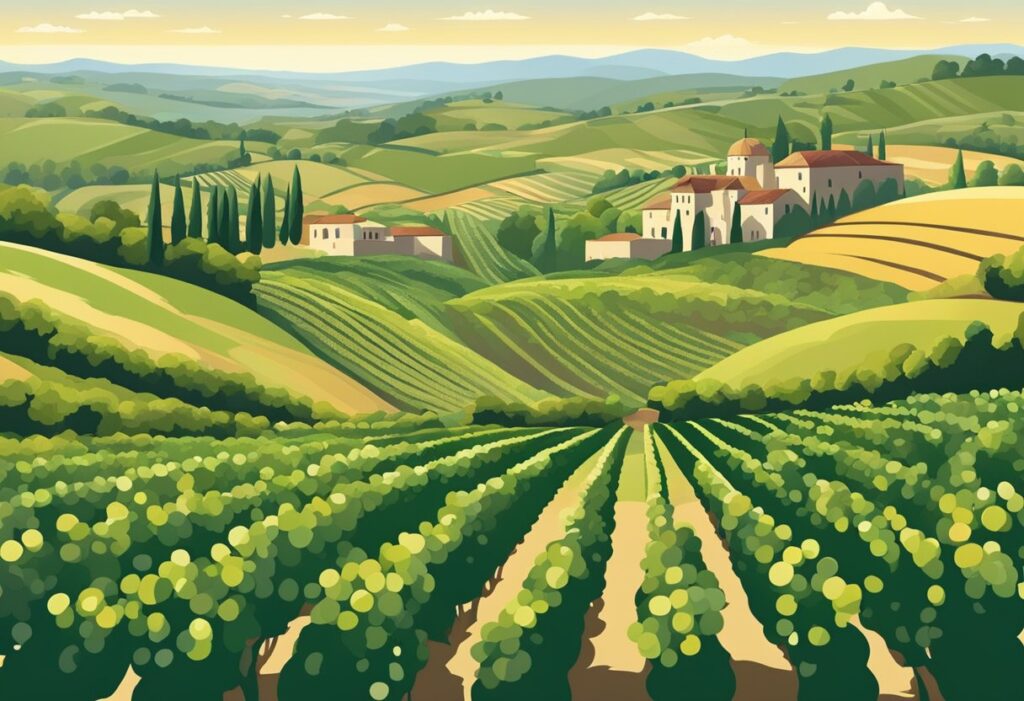
Understanding the impact of climate on wine production is crucial for appreciating the significance of terroir, which encompasses geography, geology, and climate, in creating distinctive wines. From the temperature to the timing of rainfall, each element profoundly affects the grapes’ development and, ultimately, the wine’s aroma, flavor, and minerality.
Continental and Maritime Effects
Continental climates, characterized by large temperature variations between day and night and between seasons, are prevalent in interior regions far from the sea, like certain parts of France. This variance can lead to dense, tannic wines with the ability to age well.
In contrast, maritime climates, with more stable temperatures due to the influence of large bodies of water, yield softer, fruitier wines. These conditions affect the ripening process and, therefore, the sugar, acid, and aromatic profiles of the grapes.
Mediterranean Climate and Wine
A Mediterranean climate is key to renowned wine regions in Italy, Spain, and southern France. It’s marked by warm, dry summers and mild, wet winters, fostering consistent grape maturation. This climate engenders wines noted for their rich fruit flavors and a certain earthy quality. The consistency of the Mediterranean sun helps preserve grape acidity while encouraging ripening that doesn’t erode the grapes’ nuanced flavors.
High Altitude Winegrowing
Grapes grown at high altitudes face more intense sunlight and cooler nights. These conditions can lead to a slower, more balanced ripening process, often enhancing the grapes’ natural sugars and maintaining crisp acidity. In regions of Spain or Italy with vineyards at varying altitudes, you can discern remarkable differences in body and complexity because altitude profoundly influences a wine’s character.
Winemaking Techniques and Advances
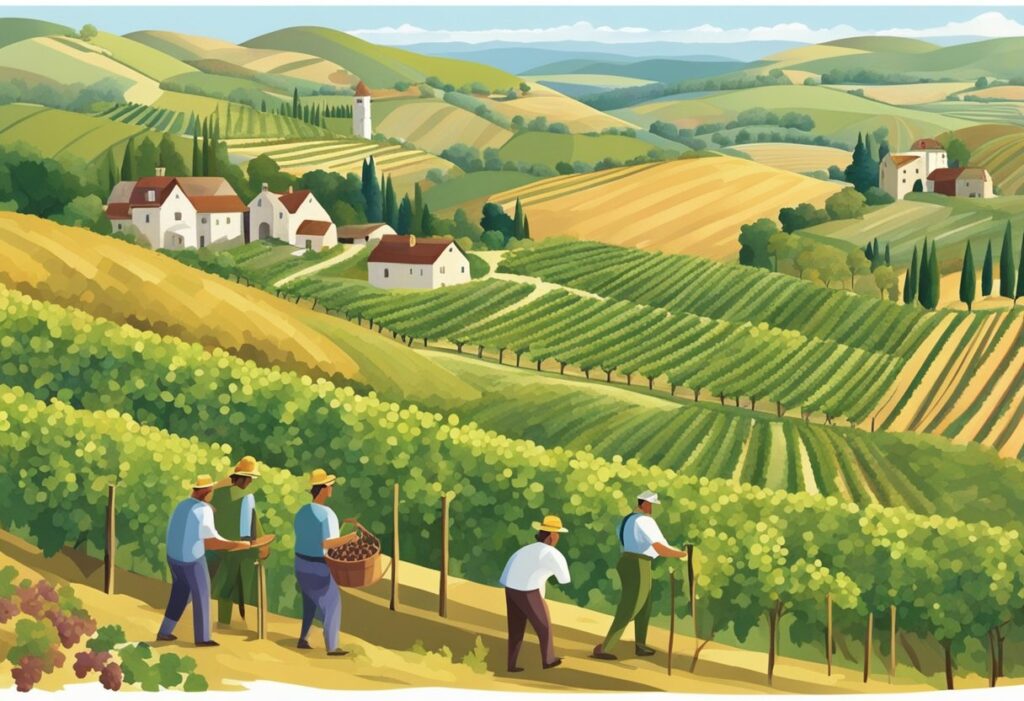
Winemaking techniques have significantly evolved from ancient practices to incorporate both traditional methods and cutting-edge technological advances. These improvements aim to enhance wine quality and sustainability.
Traditional vs Modern Methods
Traditional winemaking often involved foot-stomping and fermentation in large, open-topped wood vats, which is labor-intensive and less predictable. In contrast, modern methods have introduced the precise control of conditions, such as the use of temperature-controlled fermentation, which leads to more consistent and high-quality wines. The Industrial Revolution also brought significant changes to winemaking, mechanizing many processes that were once done by hand.
Biodynamic and Organic Trends
The push towards sustainability has seen a rise in biodynamic and organic winemaking practices. These methods shun chemical intervention, relying instead on ecological balance and lunar cycles, and have been detailed in advancements in biodynamic wine practices. This trend not only connects tradition with modern environmental concerns but also often results in a wine that reflects the terroir more profoundly.
Technology in Viniculture
Advancements in technology have revolutionized winemaking with new machinery and scientific approaches, from developments in grape analysis to innovations in storage techniques such as steel tank fermentation. Modern viniculture embraces a range of innovations in wine production from drones mapping vineyard health to automated harvesters, enhancing efficiency and precision in winemaking.
Unique Wine Styles and Variations
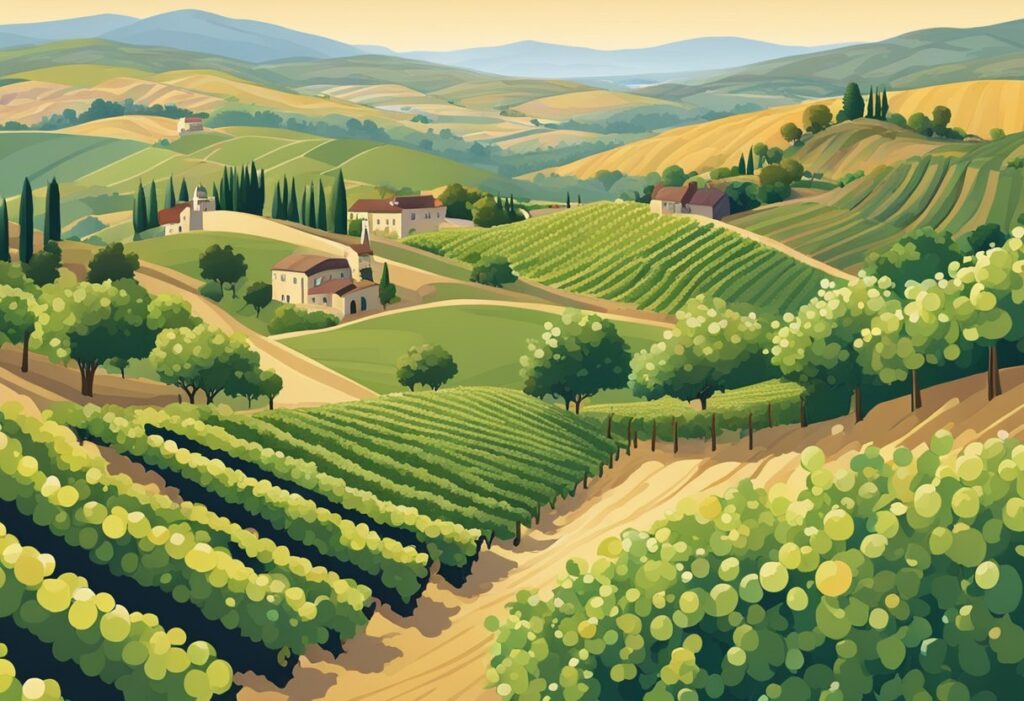
In the vast world of wines, certain styles and variations stand out for their unique production methods and distinctive taste profiles. As you explore the realm of vintages and vineyards, these exceptional categories offer a glimpse into the intricate world of winemaking.
Sparkling Wines and Champagne
Sparkling wines are celebrated for their effervescence, achieved through natural fermentation that traps carbon dioxide and creates those characteristic bubbles.
Champagne, the most illustrious of sparkling wines, hails from its namesake region in France, where strict regulations govern its production—to be called Champagne, the wine must not only come from the Champagne region but also adhere to rigorous standards. Sparkling wines from other regions, like Prosecco from Italy or Cava from Spain, offer diverse styles and flavors.
- Notables:
- Champagne: Complex, with notes of almond, citrus, and toast.
- Prosecco: Lighter, fruitier with a touch of sweetness.
- Cava: Earthy, with hints of pear and apple.
Fortified and Sweet Wines
Fortified wines possess a higher alcohol content, typically the result of adding a distilled spirit such as brandy during the winemaking process. This category includes rich Port, aromatic Sherry, and the honeyed flavors of Madeira. Sweet wines, often enjoyed as dessert wines, range from the late harvest delights to lusciously sweet ice wines, harvested from grapes frozen on the vine, creating a unique wine style that concentrates sugar and flavor.
- Examples:
- Port: Typically sweet, with robust berry and chocolate notes.
- Ice wine: Intensely sweet, often with citrus or tropical fruit flavors.
Rosé and Lesser-Known Types
Rosé, known for its pink hue, is crafted by allowing red grape skins to remain in contact with the juice for a short period. This results in a wine that combines the characteristics of red and white wines, suitable for various occasions and palates. Additionally, there are lesser-known types of wines made from unique varietals or through special methods, offering you a wide spectrum of tastes and experiences.
- Traits:
- Rosé: Can range from dry to sweet, often with red fruit and floral notes.
- Other Types: May include local varietals exclusive to specific regions.
By understanding these unique wine styles and variations, you elevate your appreciation for the diverse and rich tapestry of winemaking traditions that exist across the globe. Whether you prefer the bubbly personality of a sparkling wine, the depth of a fortified wine, or the refreshing charm of a rosé, each glass tells a story of its origin and craftsmanship.
Cultural Significance of Wine
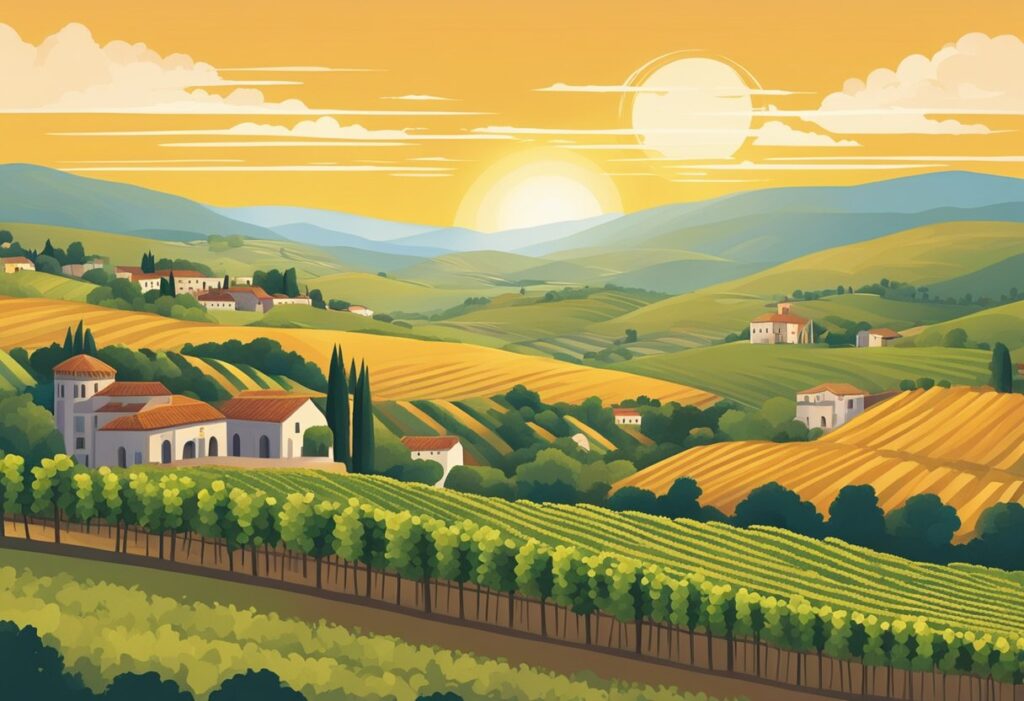
Wine’s impact extends beyond mere consumption; it influences societal norms, religious practices, economies, and even global trade dynamics.
Wine in Religion and Society
In many cultures, wine holds a sacred place in religious ceremonies and societal functions. From its use in Christian Communion to Jewish Passover seders, wine is symbolic of spirituality and community. The Mediterranean region, with its deep-seated wine traditions, often sees wine as a connector of family and friends, enhancing the quality of life and gatherings.
Wine Tourism and Economy
Wine tourism has become a lucrative aspect of local economies, particularly in regions famous for their wineries. Visitors flock to areas like Napa Valley and Bordeaux to experience wine culture first-hand, sampling premium wines and learning about the production process. This influx of tourists bolsters regional economies and supports local businesses, from vineyards to hospitality.
Global Wine Trade and Market
The global wine market reflects the complex interplay of tradition, taste, and economic forces. As winemaking techniques have been refined, regions like France, Italy, and Spain have established themselves as major players in international wine trade, contributing to the shared global heritage of wine culture. Wine’s cultural significance transcends borders, influencing dining, social etiquette, and even investment in the ever-growing and competitive global marketplace.
Wine Labeling and Appellation Systems
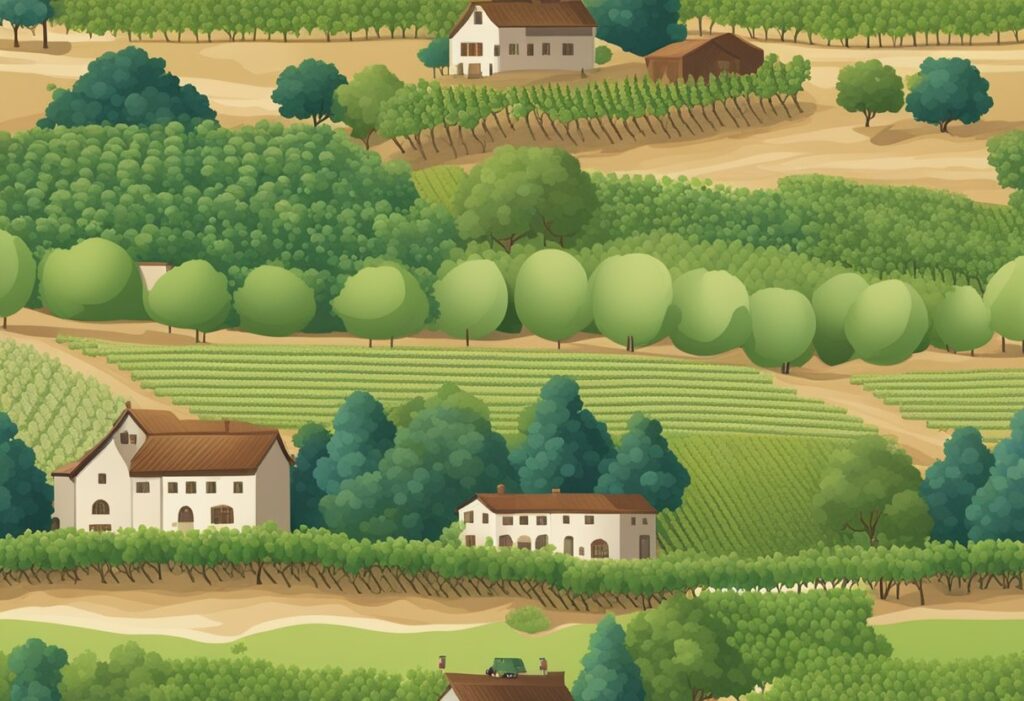
Understanding wine labeling and appellation systems is crucial for deciphering the history and quality of wine. These systems reflect traditional practices and regional characteristics, essential for both Old World and New World wines.
Old World Classifications
In the Old World, particularly in Europe, appellation systems serve as a heritage of winemaking. France is renowned for its Appellation d’Origine Contrôlée (AOC) system, which ensures that wines meet strict production and geographical criteria. For instance, a Burgundy wine must adhere to rules regarding grape types, vineyard yields, and other parameters to stake its claim as AOC-certified.
Similarly, Italy‘s highest classification, Denominazione di Origine Controllata e Garantita (DOCG), represents wines that are not only produced in specified regions but also have met rigorous quality tests. The Barolo and Barbaresco wines are classic examples, needing to meet designated aging periods to be designated as DOCG.
New World Labeling Practices
The New World wine regions, including countries like the USA, Australia, and Chile, adopted different labeling practices. They often emphasize the grape variety rather than the region. The United States uses an American Viticultural Area (AVA) to define wine grape-growing regions with distinct geographic features. For example, a wine labeled as Napa Valley must source at least 85% of its grapes from that specific AVA.
In contrast, Australia does not have a formal appellation system but uses Geographic Indications (GI) to indicate where grapes are grown. The system is less about winemaking heritage and more about the characteristics of the wine’s origin.
Challenges and the Future of Winegrowing
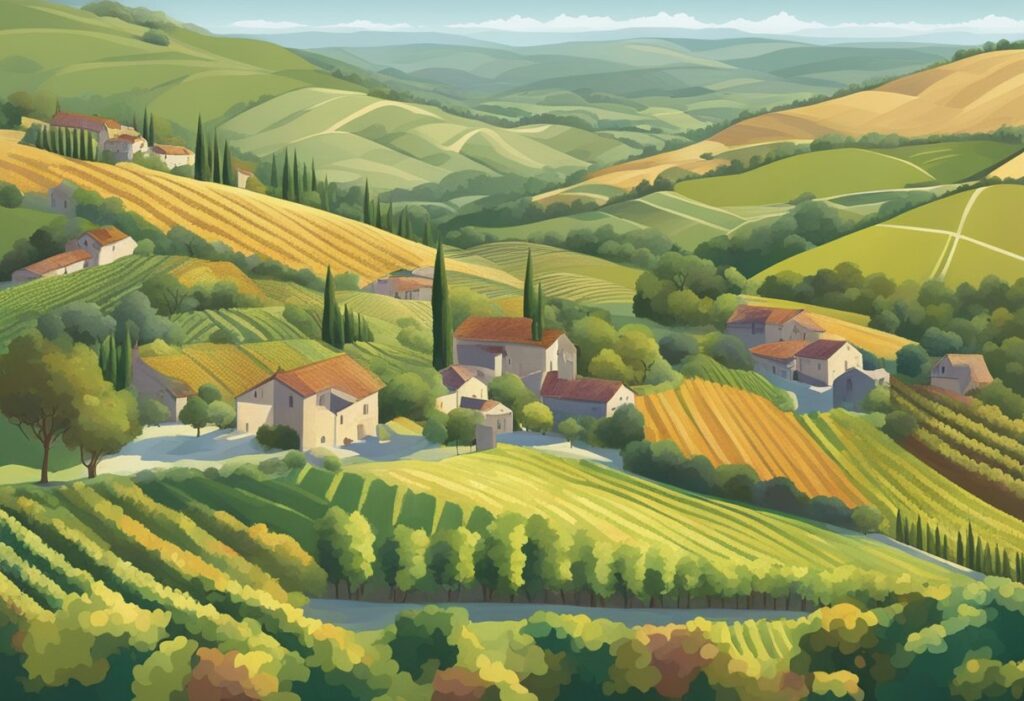
The wine industry faces significant challenges ahead, particularly in adapting to climate change, improving sustainability, and adopting new cultivation innovations.
Climate Change Impact on Vineyards
Climate change poses a severe risk to traditional winegrowing regions. As temperatures rise, regions previously ideal for growing wine grapes could see a dramatic reduction in suitability. Heat can accelerate ripening, potentially leading to higher sugar content and lower acidity in grapes, which affects the quality of the wine.
Some regions are exploring a transition to varieties better suited to the shifting conditions, such as switching from Pinot to Xinomavro in certain areas. Vintners may also have to confront the increased frequency of extreme weather events, from frost to hail, challenging the viability of wine production in their current locations.
Sustainability in the Wine Industry
The wine industry is vigorously pursuing sustainability. This includes water conservation, reducing carbon footprint, and implementing organic and biodynamic farming practices. Renewable energy sources like solar and wind are also becoming more prevalent in vineyards and wineries, aiming to curb the sector’s environmental impact.
The circular economy model is being integrated, where waste products are repurposed, thus minimizing waste. Building a sustainable wine industry not only helps in adapting to climate change but also ensures that the industry can continue to thrive for future generations.
Innovations in Grape Cultivation
Innovations in grape cultivation are key to the wine industry’s future. Scientists and viticulturists are cultivating new grape varieties resistant to pests, diseases, and more extreme weather. Some are also leveraging advanced technologies such as drones for monitoring vine health, precision irrigation systems to optimize water use, and data analytics to predict vineyard conditions.
These innovations help you maintain the quality of your wine while adapting to the changing environment. Additionally, historical challenges like the phylloxera epidemic showcase the industry’s resilience and capacity for reinvention through viticulture advancements.
By embracing adaptive strategies, the wine industry aims to navigate the difficulties imposed by a changing climate and to prosper sustainably for years to come.
